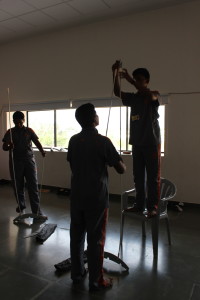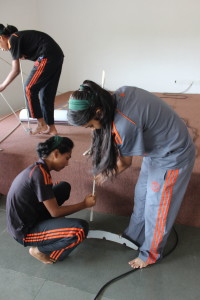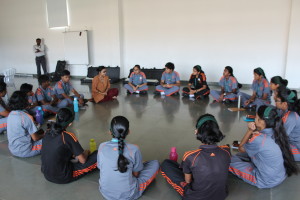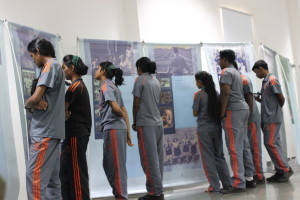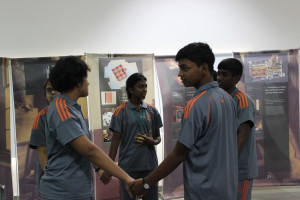For me, the most interesting aspect of ‘Anne Frank—A History for Today’, the international traveling exhibition, is the fact that it engages on multiple levels. There is of course—the visual aspect—photographs of Anne, her family, the very real and unimaginable suffering that countless people had to go through. Then there are the first person accounts. And then perhaps the most important aspect, that students roughly the same age as Anne, are the guides for the exhibition. This takes the engagement to a different and much more personal level.
The setting up itself was smooth sailing, with some minor hiccups along the way (‘Why isn’t this panel looking straight?’ and so on) and the peer guides were raring to go. The young curators as they now were, discussed ways they could make the arrangement of the panels more appealing and even took into consideration the use of light in the hall they were using.
After a break, the eighteen peer guides from classes 9 and 10 gathered in a circle for a discussion. One of the students told her friends about the diary and about Anne, and another student explained the background—Germany’s economic condition and the rise of Hitler. With this background, they went back to the panels, going through each one carefully. Once this was done, I asked them which panel spoke to them the most. One of the students said that as an aspiring writer, the panel that she could relate to the most was the one in which Anne talks about her dreams and ambitions for the future. Another spoke about the panels in which we are told about Anne’s friends and how friendship is so important-then and now. Many of the students said that the panel in which we are told about Otto Frank discovering that his family was dead was the one that really moved them. Some of the students spoke about how Hitler managed to sway the German populace-and the reasons why he was so successful. The fact that the Nazis murdered disabled people was shocking to many of them.
After going through the panels once more we played a game on social exclusion. This game—with two groups of students trying to prevent another smaller group from entering their group—has proven to be very effective in initiating a discussion on social exclusion. After the game we discussed how social exclusion was a basis of the holocaust and how, even on a smaller scale exclusion is prevalent. Students mentioned examples of exclusion that they have encountered or heard about—manual scavenging, exclusion on the basis of physical appearance (for instance, colour of the skin), exclusion of ‘nerds’ in the classroom, the age-old discrimination against Dalits and exclusion and discrimination based on religion. They spoke about instances of abuse of power that they have seen, particularly corruption. Instances that have made them speak out.
One of the students came with the idea of creating their own diary mimicking Anne’s. One that would document their own experiences as peer guides. I don’t know if they will, but I hope that they do, because if this day was any indication, we have a group of young human rights defenders.
-Paroma Sengupta

